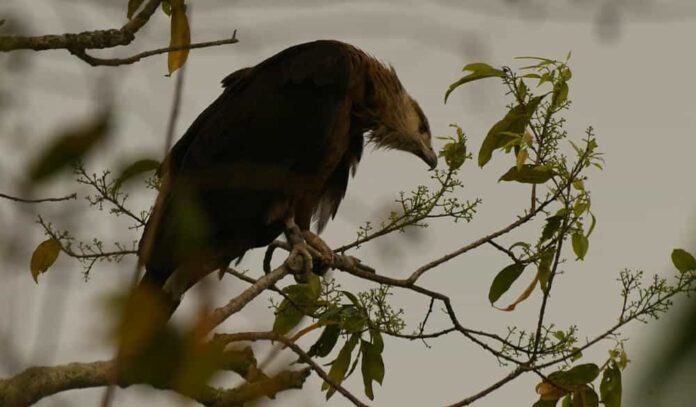Kaziranga National Park, one of India’s most renowned wildlife sanctuaries, has once again become the focal point of international wildlife conservation as a rare Mongolia-tagged endangered eagle was spotted in the park for the fifth consecutive year. This remarkable sighting highlights both the ecological significance of Kaziranga and the importance of global conservation efforts in protecting endangered species.
The eagle, believed to have been tagged in Mongolia as part of an international tracking project, is a testament to the success of cross-border conservation initiatives. Its regular return to the protected grasslands of Kaziranga has intrigued ornithologists and conservationists alike, making this recurring phenomenon a valuable case study in the protection of migratory species.
The Importance of Kaziranga in Global Wildlife Conservation
Kaziranga National Park, a UNESCO World Heritage Site, is located in the northeastern state of Assam in India. Famous for its population of one-horned rhinoceroses, Kaziranga also supports a rich diversity of wildlife, including tigers, elephants, and a variety of bird species. Its vast grasslands and wetlands make it an ideal habitat for migratory birds, and the park has become a crucial sanctuary for endangered species.
This recent sighting of the Mongolia-tagged eagle adds another layer of importance to Kaziranga’s role in international conservation. The eagle is part of a species that has been classified as endangered, with their numbers dwindling due to habitat loss, illegal hunting, and climate change. The eagle’s regular presence in Kaziranga serves as a positive indicator that the park’s ecosystem remains conducive to the survival of such species.
The Mongolia-Tagged Eagle: A Symbol of Conservation Success
The eagle spotted in Kaziranga is part of a global tagging and tracking initiative that began several years ago in Mongolia. Mongolia is home to one of the largest populations of this endangered eagle species, and conservationists have worked tirelessly to monitor their movements and migration patterns through advanced satellite tagging technology.
By attaching GPS tracking devices to the eagles, scientists are able to gain insights into their migration routes, feeding habits, and breeding grounds. The tagged eagles travel vast distances between breeding areas in Mongolia and wintering grounds in India and other parts of Asia. The data collected from these tags provides valuable information that can be used to develop targeted conservation strategies.
This eagle’s return to Kaziranga year after year is a significant achievement, signaling that the park’s environment is supportive of its needs. Conservationists have been able to track the eagle’s movements, confirming that the bird has traveled thousands of kilometers to return to this particular habitat in India, reinforcing the importance of Kaziranga as a critical stopover point for migratory birds.
The Role of International Cooperation in Wildlife Protection
The repeated sightings of this endangered eagle in Kaziranga are not only a testament to the park’s role in protecting wildlife, but they also reflect the growing importance of international cooperation in wildlife conservation. The collaboration between Indian wildlife authorities, Mongolian conservationists, and international wildlife organizations has proven to be effective in protecting species that migrate across national borders.
The Mongolian government, in partnership with international conservation groups, has been working to protect the eagle’s breeding grounds, while India has committed to safeguarding the migratory routes and habitats of these birds. The efforts to tag and track the eagle are part of a broader strategy to ensure the species’ survival and address the challenges posed by climate change and habitat degradation.
Kaziranga itself is a model of conservation success, with its well-managed protection programs, anti-poaching initiatives, and strict enforcement of wildlife laws. The presence of the Mongolia-tagged eagle for five consecutive years underscores the effectiveness of these measures, as well as the crucial role that protected areas like Kaziranga play in preserving biodiversity.
Threats to Endangered Eagles and Their Migration Routes
While the sighting of the Mongolia-tagged eagle is a hopeful sign for conservationists, the species is still under threat. Habitat loss due to deforestation, illegal hunting, and poaching remain significant challenges for endangered birds, including the eagle. Furthermore, climate change is altering migration patterns and putting stress on species that rely on specific ecosystems for survival.
The Mongolian eagle’s long journey from its breeding grounds to Kaziranga highlights the challenges migratory species face. The destruction of wetlands, grasslands, and other habitats along the migration route can disrupt the eagle’s access to essential food sources and resting spots. As human activity continues to encroach on wildlife habitats, the need for stronger conservation measures becomes even more urgent.
Conservation Efforts Moving Forward
Looking ahead, the continued monitoring of the Mongolia-tagged eagle is essential in understanding the challenges it faces throughout its migration. Further efforts to protect both the breeding grounds in Mongolia and the wintering habitats in India, including Kaziranga, will be crucial in ensuring the species’ long-term survival.
In addition to the satellite tagging initiative, local communities are being engaged in conservation efforts, with initiatives to raise awareness about the importance of protecting endangered species. By involving local populations in conservation activities, there is a greater chance of ensuring sustainable and effective wildlife protection.
Kaziranga National Park continues to be at the forefront of these conservation efforts, providing a safe haven for a variety of endangered species, including the Mongolia-tagged eagle. The park’s ongoing success in hosting these rare visitors demonstrates the importance of maintaining and expanding protected areas, especially in the face of growing environmental challenges.
The sighting of the Mongolia-tagged endangered eagle in Kaziranga for the fifth consecutive year is a remarkable achievement for both Indian and international wildlife conservation efforts. It highlights the vital role that Kaziranga plays in the protection of migratory species and the success of global conservation initiatives. As we move forward, the continued collaboration between countries and conservation organizations will be essential in securing the future of such endangered species, ensuring that they continue to thrive for generations to come.




